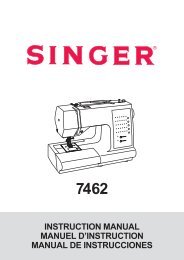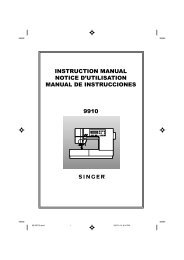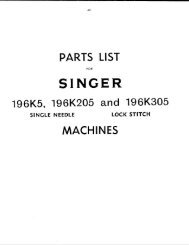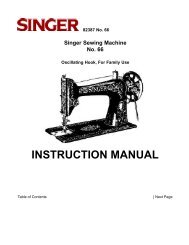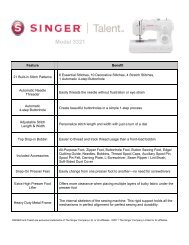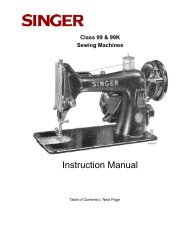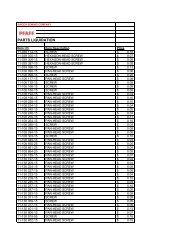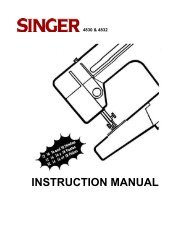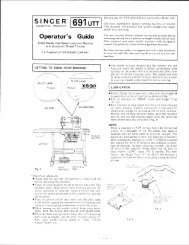Instruction Book Libro de Instrucciones Livret d'Instructions ... - Singer
Instruction Book Libro de Instrucciones Livret d'Instructions ... - Singer
Instruction Book Libro de Instrucciones Livret d'Instructions ... - Singer
You also want an ePaper? Increase the reach of your titles
YUMPU automatically turns print PDFs into web optimized ePapers that Google loves.
Adjusting thread tension<br />
When an even amount of tension is exerted on<br />
both threads, a smooth even stitch, known as a<br />
balanced stitch, is produced.<br />
Correct tension is important because too much<br />
or too litle will weaken your seams or cause your<br />
fabric to pucker. Make a test sample with the<br />
fabric and thread you plan to use and examine<br />
it.<br />
A perfect, well balanced stitch (1), will have the<br />
needle and bobbin threads locked between the<br />
two layers of fabric with no loops on top or<br />
bottom and no puckering.<br />
Too much tension will produce a tight stitch (2)<br />
which will cause the fabric to pucker.<br />
To <strong>de</strong>crease tension, turn the dial to a lower<br />
number.<br />
Too little tension will produce a loose stitch (3)<br />
which will cause loops in your seam.<br />
To increase tension, turn the dial to a higher<br />
number.<br />
Ajuste <strong>de</strong> la tensión<br />
<strong>de</strong>l hilo<br />
Cuando se ejerce una tensión uniforme sobre<br />
ambos hilos, el resultado es un punto uniforme,<br />
llamado punto equilibrado.<br />
Una tensión correcta es importante porque un<br />
exceso o una falta <strong>de</strong> tensión pue<strong>de</strong> repercutir<br />
en las costuras o hacer fruncir el género. Haga<br />
una prueba con el género y el hilo que piensa<br />
utilizar y examínelo.<br />
Un punto correcto y bien equilibrado (1), tendrá<br />
el hilo <strong>de</strong> la aguja y el <strong>de</strong> la bobina entrelazados<br />
entre las dos capas <strong>de</strong> género, sin lazos ni<br />
frunces por arriba ni por abajo.<br />
Demasiada tensión producirá un punto tirante<br />
(2) y hará fruncir el género.<br />
Para disminuir la tensión, gire el disco a un<br />
número inferior.<br />
Muy poca tensión producirá un punto flojo (3) y<br />
se formarán lazos a lo largo <strong>de</strong> la costura.<br />
Para aumentar la tensión, gire el disco a un<br />
número más alto.<br />
Point droit<br />
extensible<br />
Lorsque vous utilisez le triple point droit extensible<br />
pour les coutures qui subissent <strong>de</strong> fortes<br />
tensions (tricot, jersey, tissus extensibles), la<br />
conception même du point renforce la couture.<br />
Pour surpiquer, placez l’ouvrage sous le pied<br />
presseur, l’endroit du vêtement au-<strong>de</strong>ssus.<br />
Réglages recommandés<br />
Sélection <strong>de</strong> point: Droit extensible (A)<br />
Position d’aiguille:<br />
Largeur <strong>de</strong> point:<br />
Longueur <strong>de</strong> point: Symbole ( )<br />
Pied presseur: Spécial (J)<br />
Plaque à aiguille: Universelle (A)<br />
Baissez le pied presseur et commencez à<br />
piquer en tenant les fils pendant les premiers<br />
points.<br />
Gui<strong>de</strong>z légèrement le tissu pendant la couture<br />
en laissant à la machine la possibilité <strong>de</strong> faire<br />
son mouvement <strong>de</strong> va et vient avant-arrière.<br />
Repassez la couture.<br />
Point Ric Rac<br />
C’est un point extensible très soli<strong>de</strong>, à utiliser<br />
pour la finition <strong>de</strong>s bords.<br />
Assemblez les coutures et repassez.<br />
Pour les finitions <strong>de</strong> bords tubulaires, utilisez le<br />
bras-libre <strong>de</strong> la machine.<br />
Réglages recommandés<br />
Sélection <strong>de</strong> point: Ric-rac (B)<br />
Position d’aiguille:<br />
Largeur <strong>de</strong> point:<br />
Longueur <strong>de</strong> point: Symbole ( )<br />
Pied presseur: Spécial (J)<br />
Plaque à aiguille: Universelle (A)<br />
Placez l’endroit du tissu sous le pied presseur.<br />
Piquez lentement au bord.<br />
Passez les fils sur l’envers du travail; nouez-les<br />
et coupez.<br />
30 59<br />
12 3 4 5<br />
12<br />
3 4 5



